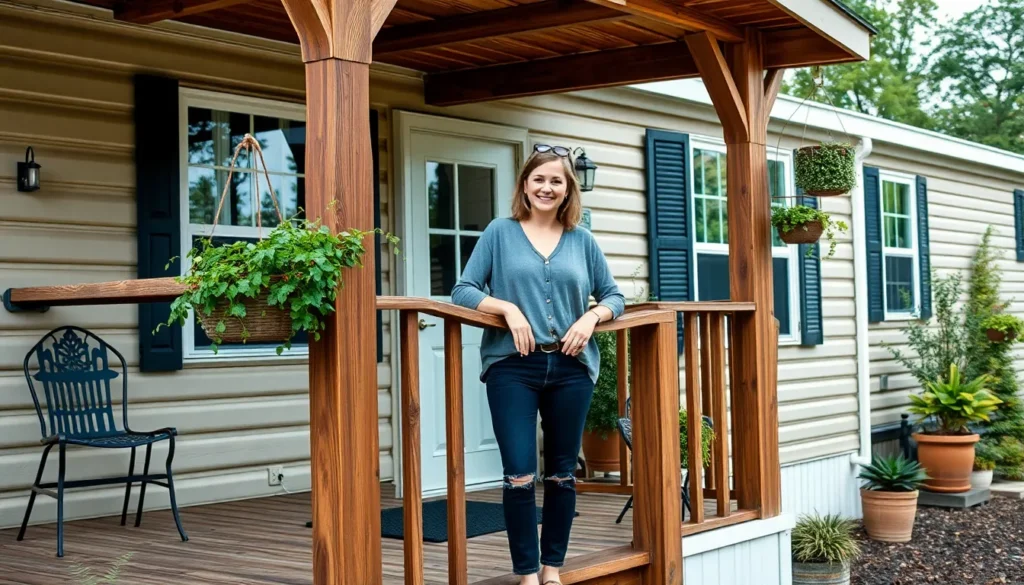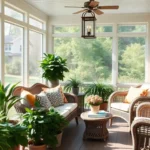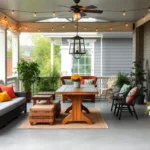Mobile homes don’t have to sacrifice curb appeal or outdoor living space. We believe your front porch should be a welcoming extension of your home that reflects your personal style while maximizing functionality.
Whether you’re working with a small stoop or planning a complete porch renovation, we’ve discovered countless creative answers that transform ordinary mobile home entrances into stunning focal points. From budget-friendly DIY projects to sophisticated design upgrades, there’s a front porch idea that’ll perfectly suit your space and lifestyle.
The best part? Most of these transformations won’t expensive or require extensive construction experience. We’ll show you how simple additions like decorative railings, strategic lighting, and thoughtful landscaping can dramatically boost your home’s value and create an inviting outdoor retreat you’ll love spending time in.
Classic Covered Porch With Traditional Appeal
Building on the foundation of functional porch design, classic covered porches bring timeless elegance to mobile home front entries through carefully selected architectural elements.
Gable Roof Design Options
Steep gable roofs create dramatic visual impact while providing excellent weather protection for mobile home porches. We recommend installing a 6/12 to 8/12 pitch ratio to achieve the classic look while ensuring proper water runoff. Traditional asphalt shingles in neutral colors like charcoal gray or weathered wood tones complement most mobile home exteriors.
Cross gable configurations add architectural interest by incorporating multiple roof peaks that create depth and dimension. This design works particularly well for larger mobile home porches spanning 12 feet or more in width. Metal roofing in standing seam or corrugated styles offers durability and matches the practical nature of mobile home construction.
Hip and gable combinations provide versatility for mobile homes with varying rooflines or irregular front facades. These hybrid designs allow us to customize the porch roof to complement existing architectural features while maintaining traditional appeal.
Column and Post Configurations
Square wooden posts measuring 6×6 or 8×8 inches deliver classic farmhouse charm that suits most mobile home styles. We typically space these posts 8 to 10 feet apart to provide adequate structural support while maintaining open sightlines. Pressure treated lumber ensures longevity in outdoor conditions.
Tapered columns with wider bases create refined elegance reminiscent of Craftsman architecture. These columns work exceptionally well when paired with stone or brick pier foundations that elevate the mobile home porch design. Standard dimensions range from 8 inches at the top to 12 inches at the base.
Round columns offer softer lines that complement curved or rounded mobile home features. Fiberglass and PVC options provide low maintenance alternatives to traditional wood while maintaining authentic appearance. We recommend 8 to 10 inch diameters for proper proportional balance.
Traditional Railing Styles
Spindle railings with evenly spaced vertical balusters create the quintessential porch appearance found in classic American architecture. We install these railings at 36 to 42 inch heights to meet safety codes while maintaining comfortable armrest positioning. Spacing balusters 4 inches on center prevents small children from slipping through.
Horizontal board railings provide clean lines that complement modern mobile home designs while retaining traditional charm. These railings typically feature 1×4 or 1×6 boards with 2 to 3 inch gaps between each board. This style works particularly well when painted to match mobile home trim colors.
Lattice panel inserts combine privacy with decorative appeal by incorporating diagonal or square grid patterns within the railing framework. We recommend using vinyl lattice panels for durability and easy maintenance. These panels can support climbing plants like morning glories or clematis for added natural beauty.
Modern Minimalist Porch Designs
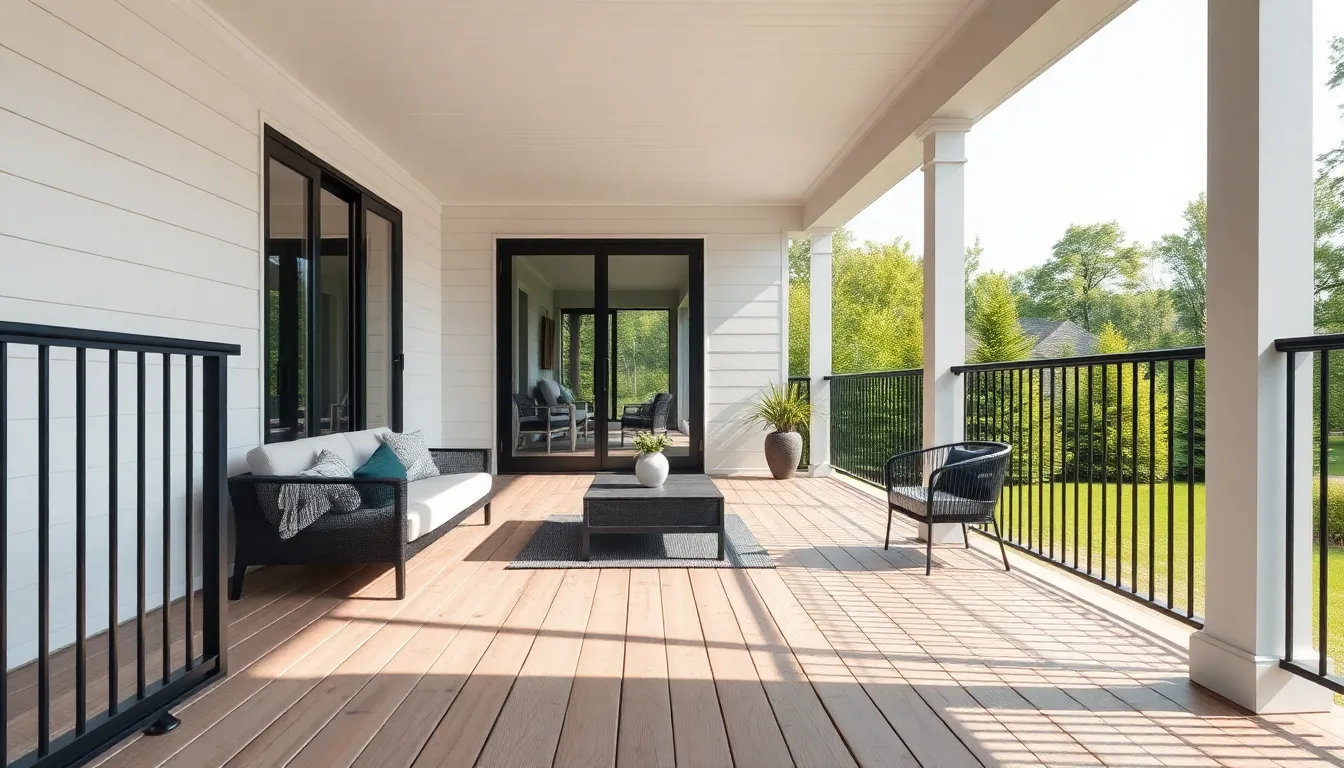
Modern minimalist porch designs offer a sleek alternative to traditional mobile home entrances, emphasizing simplicity and functionality. We’ll explore how clean aesthetics can transform your front porch into a sophisticated outdoor space.
Clean Lines and Simple Materials
Geometric shapes define the foundation of minimalist porch design, creating visual appeal through simplicity rather than ornamentation. We recommend smooth wood or composite decking with natural or muted finishes that provide durability while maintaining an understated elegance.
Metal railings with thin profiles deliver the streamlined look that minimalist design demands. Black steel options particularly excel at creating striking contrast without overwhelming the space. Concrete or stone steps establish a solid base that complements the overall aesthetic while ensuring long term functionality.
These material choices work together to create a cohesive design that’s easy to maintain and visually appealing for years to come.
Contemporary Color Schemes
Neutral palettes form the backbone of successful minimalist porch designs, with whites, grays, and blacks creating sophisticated visual harmony. We’ve found that monochromatic schemes eliminate visual clutter while allowing architectural elements to take center stage.
Muted accent colors like soft blues or greens can subtly enhance visual interest without disrupting the calm atmosphere. These restrained color choices create an inviting space that feels both modern and timeless.
Strategic color placement ensures your porch maintains its minimalist integrity while adding just enough personality to reflect your style preferences.
Streamlined Furniture Choices
Functional furniture with clean silhouettes transforms minimalist porches into comfortable outdoor living areas. We recommend simple modern chairs or benches crafted from metal or wood that complement rather than compete with the architectural elements.
Compact tables serve dual purposes for dining or decoration, with glass or metal construction maintaining the uncluttered aesthetic. Avoid bulky or heavily decorated pieces that can make your porch feel cramped or visually overwhelming.
Space efficient arrangements allow you to include essential seating while preserving the open, airy feeling that makes minimalist design so appealing.
Rustic Country Porch Ideas
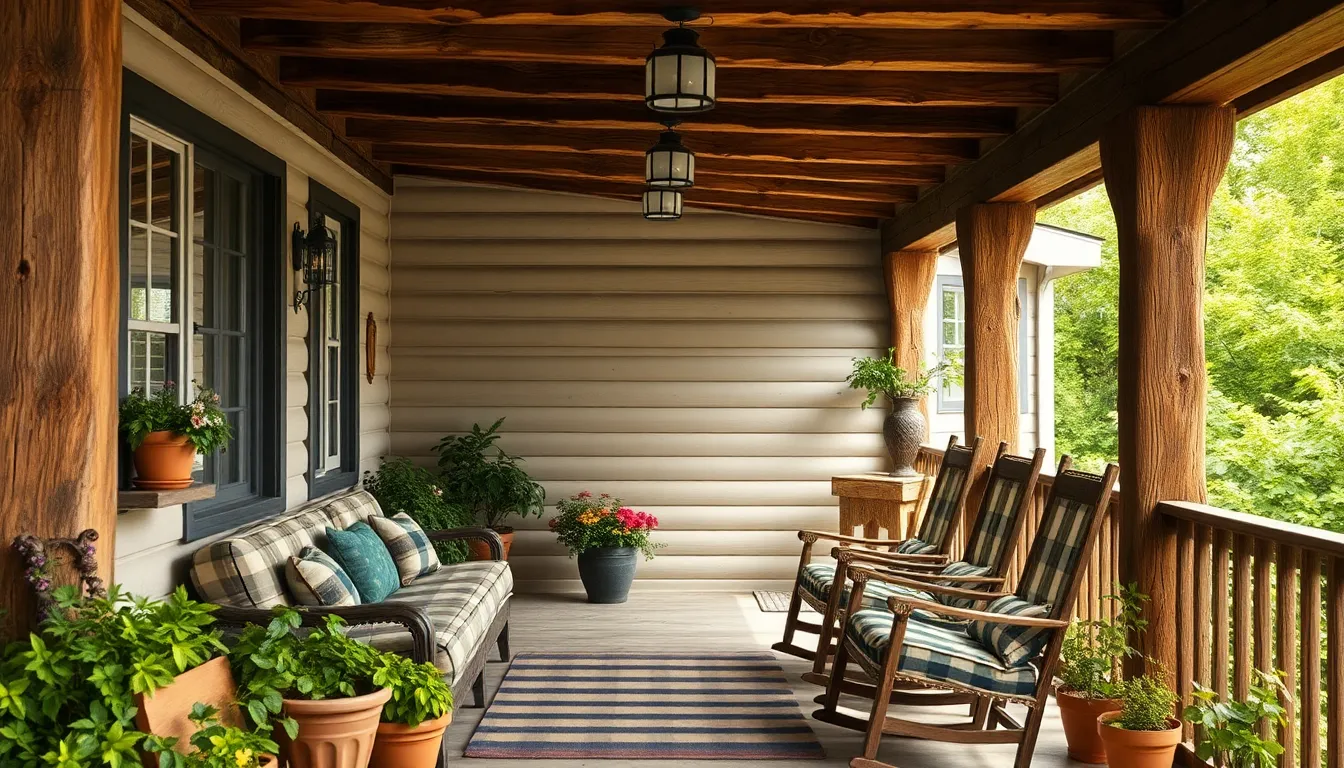
Creating a rustic country porch transforms your mobile home entrance into a warm, welcoming space that celebrates natural beauty and timeless charm. These designs embrace earthy materials and traditional elements that make every homecoming feel special.
Natural Wood Elements
Wood serves as the foundation for any authentic rustic country porch design. We recommend using exposed wooden beams and rough hewn columns to create visual interest and architectural character. Plank flooring in natural wood tones instantly establishes that coveted country atmosphere.
Combining wood with complementary materials enhances both durability and appeal. Stone or faux rock panels on porch columns provide weather resistance while maintaining rustic charm. Metal accents like wrought iron railings perfectly balance the warmth of wood without overwhelming the natural aesthetic.
Wood planters and window boxes bring nature directly onto your porch space. These elements create seamless integration between your home and surrounding industry. Natural wood stains highlight grain patterns while adding essential weather protection for long lasting beauty.
Farmhouse-Style Decorating
Farmhouse decorating emphasizes comfort and simplicity through carefully chosen design elements. Whitewashed or light colored wood creates that signature farmhouse brightness while maintaining rustic appeal. We suggest incorporating shiplap siding and barn style doors as key architectural features.
Classic porch swings and gliders provide essential farmhouse seating options. Vinyl or painted wood options offer durability while maintaining authentic styling. Black metal lantern style lighting fixtures complete the traditional farmhouse ambiance with functional beauty.
Soft textiles add the finishing touches that make farmhouse porches truly inviting. Plaid cushions and quilts on seating create cozy comfort zones. These fabric elements introduce color and pattern while maintaining the relaxed farmhouse aesthetic.
Vintage Accent Pieces
Authentic vintage pieces transform ordinary porches into character rich spaces with historical charm. Old lanterns, weathered wooden crates, and antique iron benches serve as focal points that tell stories. Repurposed furniture and salvaged materials provide genuine vintage touches at affordable prices.
| Vintage Element | Purpose | Style Impact |
|---|---|---|
| Retro flower pots | Plant displays | Colorful charm |
| Old fashioned metal signs | Wall decoration | Nostalgic appeal |
| Classic rocking chairs | Functional seating | Timeless comfort |
| Weathered wooden crates | Storage answers | Rustic texture |
Decorative layering with vintage textiles completes the authentic look. Gingham and floral prints in cushions and throws reinforce the farmhouse vintage aesthetic. These patterns connect past and present while creating visual warmth and personality.
Budget-Friendly DIY Porch Solutions
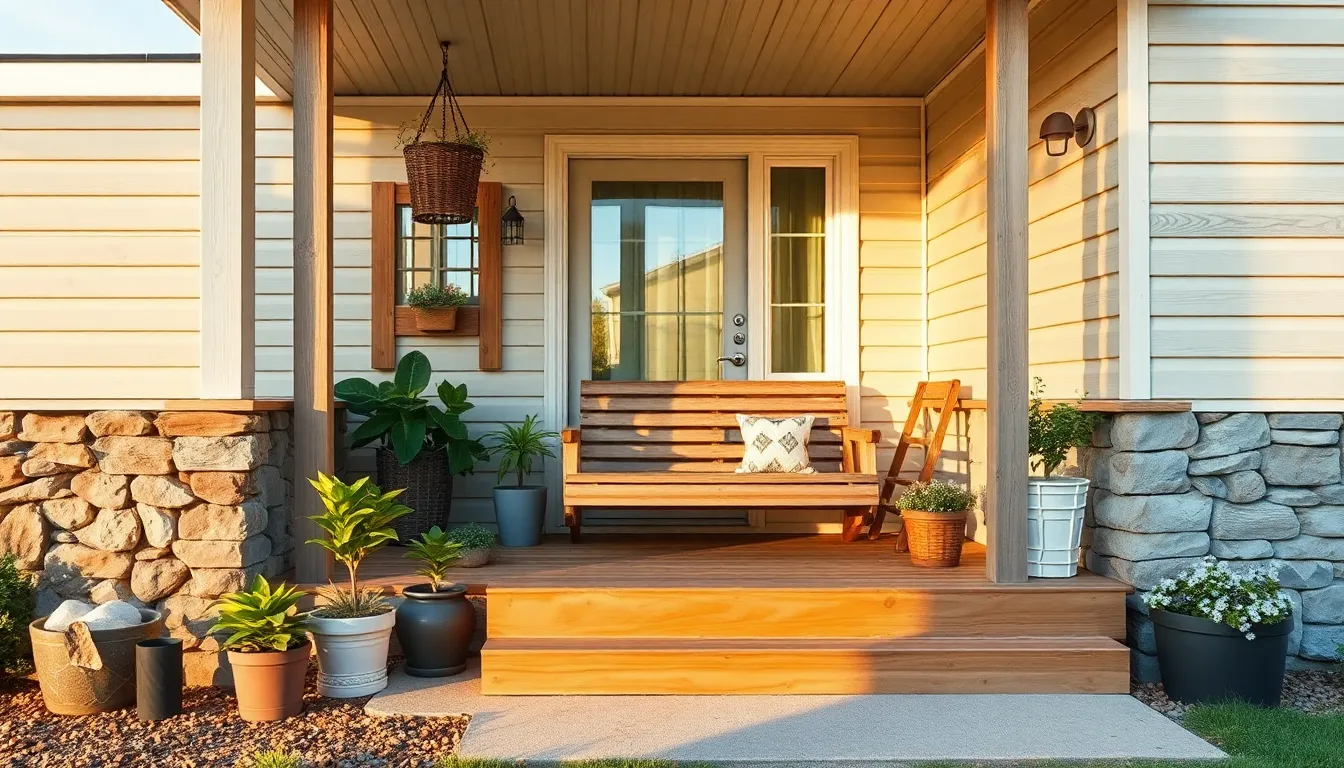
We’ve found that transforming your mobile home’s front porch doesn’t require very costly or hiring contractors. Smart material choices and simple techniques can create stunning results on any budget.
Affordable Material Alternatives
Faux rock panels offer the most cost-effective way to upgrade porch columns without the expense or structural challenges of real stone. We recommend these lightweight panels because they provide stylish visual appeal while keeping installation simple for DIY enthusiasts.
Composite decking materials deliver long-term value through reduced maintenance costs compared to traditional wood options. These materials resist weather damage and eliminate the need for annual staining or sealing treatments.
Combination approaches maximize your material investment by blending different elements strategically. We suggest pairing natural wood accents with composite structural components to balance aesthetics with durability.
Reclaimed wood pieces from previous projects or local sources can dramatically reduce material costs. Salvaged barn wood, old fence boards, or discarded deck materials often provide unique character that new lumber can’t match.
Simple Construction Projects
Basic front porch steps using 2×6 boards and deck screws create immediate curb appeal in just 1-2 hours of work. We’ve seen beginners complete this project successfully with only a miter saw, drill, and carpenter square.
Screened panel installations transform open porches into bug-free retreats over a single weekend. Door kit additions complete the enclosure while maintaining easy access to your outdoor space.
Roof extensions that follow your home’s existing pitch provide the most straightforward construction approach. This design choice eliminates complex angle calculations while ensuring proper water drainage and visual continuity.
Foundation preparation using concrete blocks or treated lumber creates stable support without expensive excavation. We recommend checking local building codes before starting any structural additions to ensure compliance.
Repurposed Decoration Ideas
Pallet porch swings bring rustic charm using materials that cost little or nothing to acquire. Sand and stain these reclaimed wood pieces to create custom seating that matches your porch’s color scheme.
Thrift store furniture provides budget-conscious furnishing options when selected carefully for outdoor durability. Metal chairs, wooden benches, and vintage plant stands often need only fresh paint to look brand new.
Mason jar lighting creates ambient illumination using battery-operated LED strings or solar components. We hang these repurposed containers at varying heights to establish warm, welcoming evening atmospheres.
Weathered crate planters organize your porch garden while adding storage functionality. Stack these containers to create vertical growing space for herbs, flowers, or trailing plants that enhance your entrance appeal.
Screened-In Porch Additions
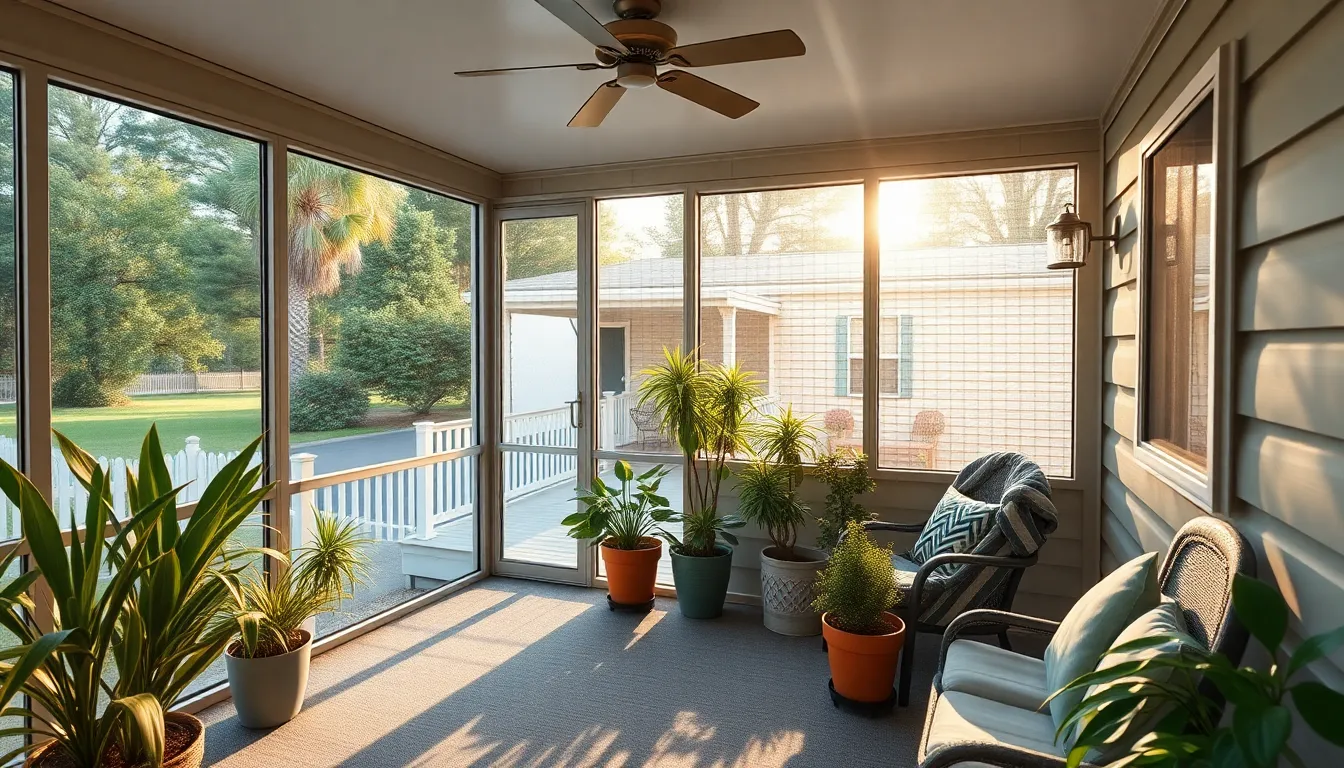
Screened-in porches offer the perfect solution for extending our outdoor living space while maintaining protection from insects and debris. These additions create comfortable environments where we can enjoy fresh air without the constant annoyance of bugs interrupting our relaxation time.
Mesh and Screen Options
Standard fiberglass screen provides our most basic level of insect protection for mobile home porches. We’ll find this option works well in moderate climates where durability demands aren’t extreme.
Pet-resistant screens offer enhanced durability when we have cats or dogs that might damage traditional screening materials. These reinforced options withstand scratching and general pet activity better than standard alternatives.
Solar mesh screens reduce sunlight and heat penetration while maintaining visibility and airflow. We can choose these specialized screens in hot, sunny climates where temperature control becomes a priority concern.
UV-blocking mesh materials protect both our porch furniture and our skin from harmful sun exposure. These screens filter dangerous rays while still allowing natural light to illuminate our outdoor space.
Weather Protection Benefits
Rain and wind protection allows us to use our screened porches throughout various weather conditions. We gain shelter from sudden storms while still enjoying the outdoor atmosphere and fresh air circulation.
Roll-down vinyl screens provide flexible weather protection that we can adjust based on current conditions. These removable panels let us close off the porch during harsh weather but open it completely during pleasant seasons.
Year-round functionality becomes possible when we incorporate proper weather barriers into our porch design. Extended seasonal use means we get maximum value from our porch investment across different climate periods.
Storm panel integration offers additional protection during severe weather events. We can install these temporary barriers when forecasts predict high winds or heavy precipitation that might damage our standard screening.
Seasonal Use Considerations
Insulated windows help retain warmth during winter months in colder climates where we want continued porch access. Storm panels provide similar thermal benefits while offering flexibility for seasonal installation and removal.
Ceiling fans improve air circulation during hot summer periods when we need cooling assistance. Portable heaters extend comfortable porch use into cooler months without permanent installation requirements.
Climate-exact adaptations ensure our screened porch remains functional throughout local weather patterns. We should consider our region’s temperature extremes and precipitation levels when selecting screening materials and accessories.
Seasonal accessory storage becomes important when we use removable panels or temporary heating answers. Planning adequate storage space helps us transition our porch setup efficiently between different seasons and weather conditions.
Small Space Porch Maximization
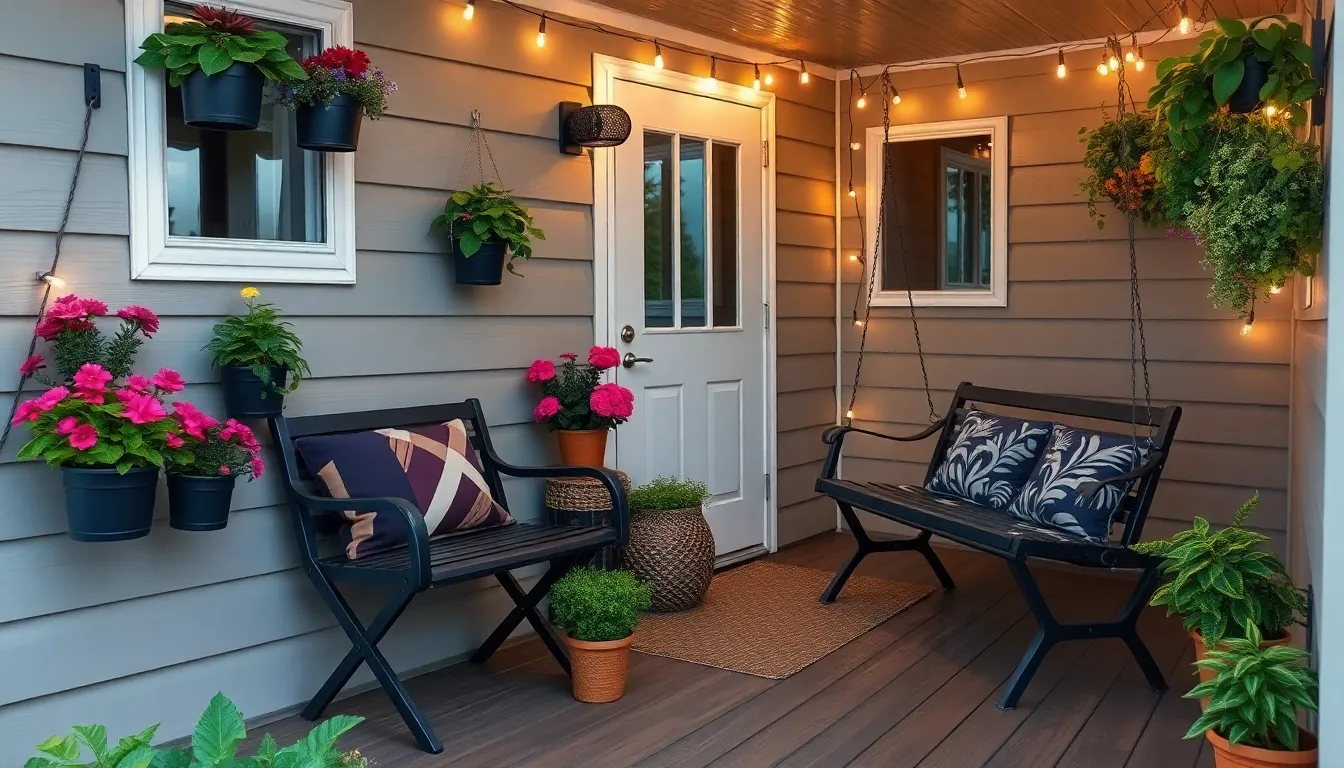
Building on our previous porch design foundations, we’ll explore how to make the most of limited square footage on mobile home porches. Smart planning and strategic design choices can transform even the smallest porch into a functional outdoor living space.
Compact Furniture Answers
Foldable tables and chairs offer flexibility when you need to maximize space during different activities. We recommend selecting pieces that stack neatly or fold flat against walls when not in use. Bench seating with built-in storage compartments serves dual purposes by providing comfortable seating while hiding outdoor cushions, gardening supplies, or seasonal decorations underneath.
Porch swings create an inviting focal point while doubling as both seating and decorative elements. Weather-resistant materials like treated wood or powder-coated metal ensure these pieces withstand outdoor conditions without frequent replacement. Multi-purpose ottomans can function as extra seating, footrests, or small tables depending on your immediate needs.
Nesting tables provide surface space when entertaining but tuck away compactly when you want an open floor plan. We suggest choosing furniture with clean lines and neutral colors to avoid overwhelming your small porch area.
Vertical Decoration Strategies
Hanging planters draw the eye upward while adding natural beauty without consuming valuable floor space. Wall-mounted shelves create display areas for plants, lanterns, or seasonal decorations along porch walls and support posts. Trellises with climbing plants like morning glories or clematis provide privacy screening while adding vertical green elements.
Outdoor wall art hung on porch posts or siding creates personality without cluttering walkways. We recommend using weather-resistant materials like metal sculptures or treated wood signs. Vertical herb gardens mounted on walls or railings offer both decoration and functionality for cooking enthusiasts.
String lights hung vertically along posts or in cascading patterns add ambiance while emphasizing your porch’s height rather than width. Seasonal wreaths and door hangings on exterior walls change your porch’s appearance throughout the year without permanent installations.
Multi-Functional Design Elements
Built-in seating with storage compartments maximizes functionality by combining comfortable seating with hidden storage for outdoor cushions and supplies. Railing planters serve as privacy screens while providing growing space for flowers, herbs, or small vegetables along porch perimeters.
Overhead coverings like awnings or extended roof overhangs protect from weather while reducing energy costs by shading interior windows. We suggest incorporating ceiling fans in covered areas to improve air circulation during warm months. Lighting fixtures that enhance both ambiance and visibility eliminate the need for separate decorative and functional lighting systems.
Window boxes beneath porch windows add curb appeal while creating additional planting opportunities without taking up floor space. Combination steps and planters integrate landscaping directly into porch construction, creating cohesive design elements that serve multiple purposes.
Wrap-Around Porch Extensions
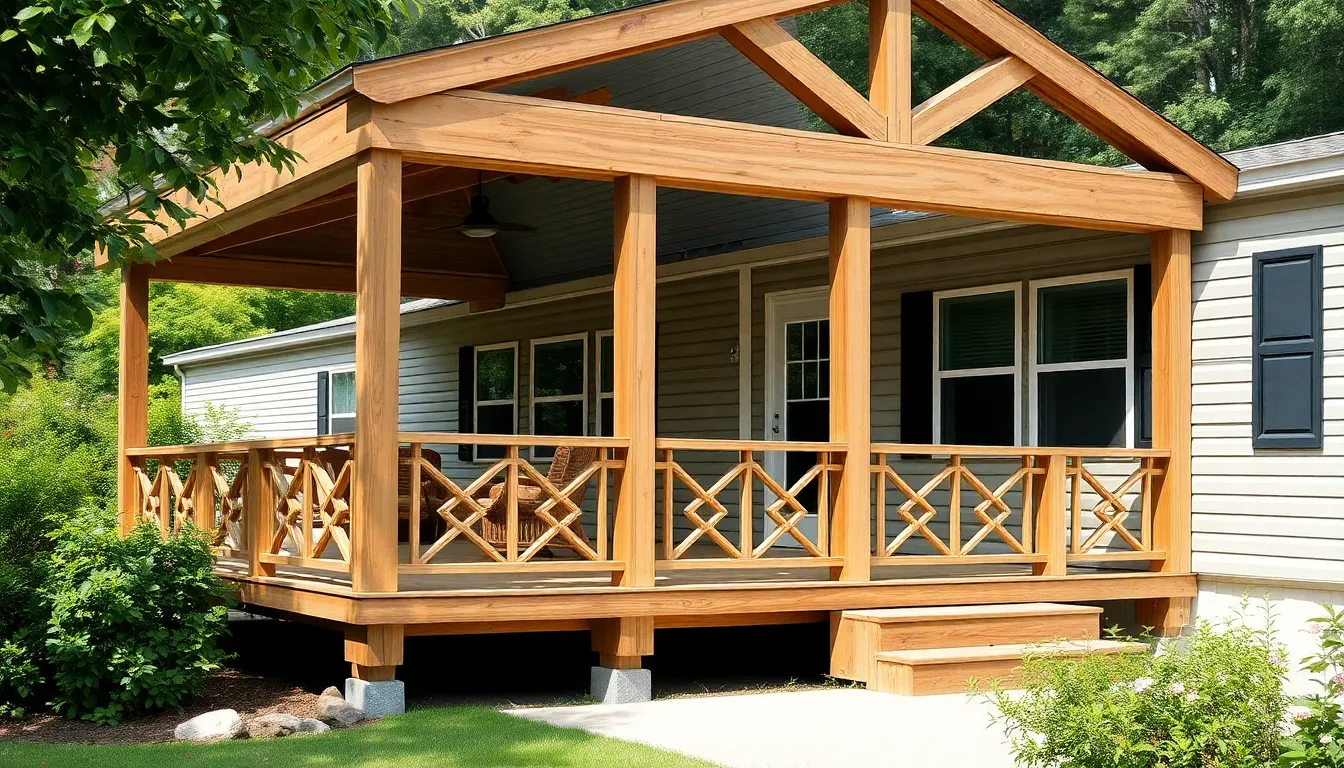
We’ve explored various porch styles, and now it’s time to discuss one of the most impressive options available. Wrap around porch extensions offer the ultimate solution for maximizing outdoor living space while dramatically boosting your mobile home’s curb appeal.
Planning and Permit Requirements
Before we begin construction, researching local building codes becomes our first priority. Most communities require permits for wrap around porch projects since these extensions significantly alter your home’s footprint and structure. We must submit applications to ensure compliance with zoning laws and safety standards.
Planning involves determining the porch’s primary purpose whether it’s for relaxation, dining, or creating additional living areas. We need to choose materials that complement our mobile home’s existing style while staying within budget constraints. Understanding community regulations prevents legal issues and avoids costly forced removal later in the process.
Documentation requirements vary by location, but we typically need detailed construction plans and material specifications. Some areas mandate professional engineer approval for structural modifications. We should contact our local building department early in the planning process to understand exact requirements for our area.
Structural Support Considerations
Mobile homes require special attention to structural stability due to their elevated design. We must install sturdy support beams and properly anchored footings to handle the additional weight and stress of a wrap around extension. These projects often take several weekends to complete due to the complexity involved.
Treated lumber provides the foundation for our support system, while reinforced columns ensure long term stability. We can enhance aesthetics by adding faux rock or log siding to these structural elements without compromising strength. Multiple corners and spans in wrap around designs demand extra attention to framing details.
Roof calculations become critical when extending from our home’s existing pitch. We must account for local weather conditions including snow loads and wind resistance. Professional consultation may be necessary for complex structural modifications to ensure safety and building code compliance.
| Support Element | Material Options | Key Considerations |
|---|---|---|
| Footings | Concrete piers, deck blocks | Must be below frost line |
| Beams | Treated lumber, steel | Load bearing capacity |
| Columns | Wood posts, metal supports | Decorative options available |
| Roofing | Metal, shingles, membrane | Weather resistance priority |
Design Flow Integration
Successful wrap around porches feel like natural extensions rather than obvious additions to our mobile homes. We achieve this by matching architectural styles and materials to maintain visual harmony throughout the entire structure. Screened sections can provide comfort and bug protection while preserving the overall design aesthetic.
Railings, steps, and lighting contribute significantly to both usability and appearance. We should consider door placement carefully to ensure easy access and maintain good traffic flow patterns. Sightlines become important for enjoying outdoor views and creating pleasant gathering spaces.
Features like built in seating and decorative elements help tie the porch into our home’s existing character. We can incorporate storage answers within the design to maximize functionality without cluttering the space. Color coordination between the porch and main structure creates a cohesive appearance that enhances overall curb appeal.
Seasonal Porch Decorating Ideas
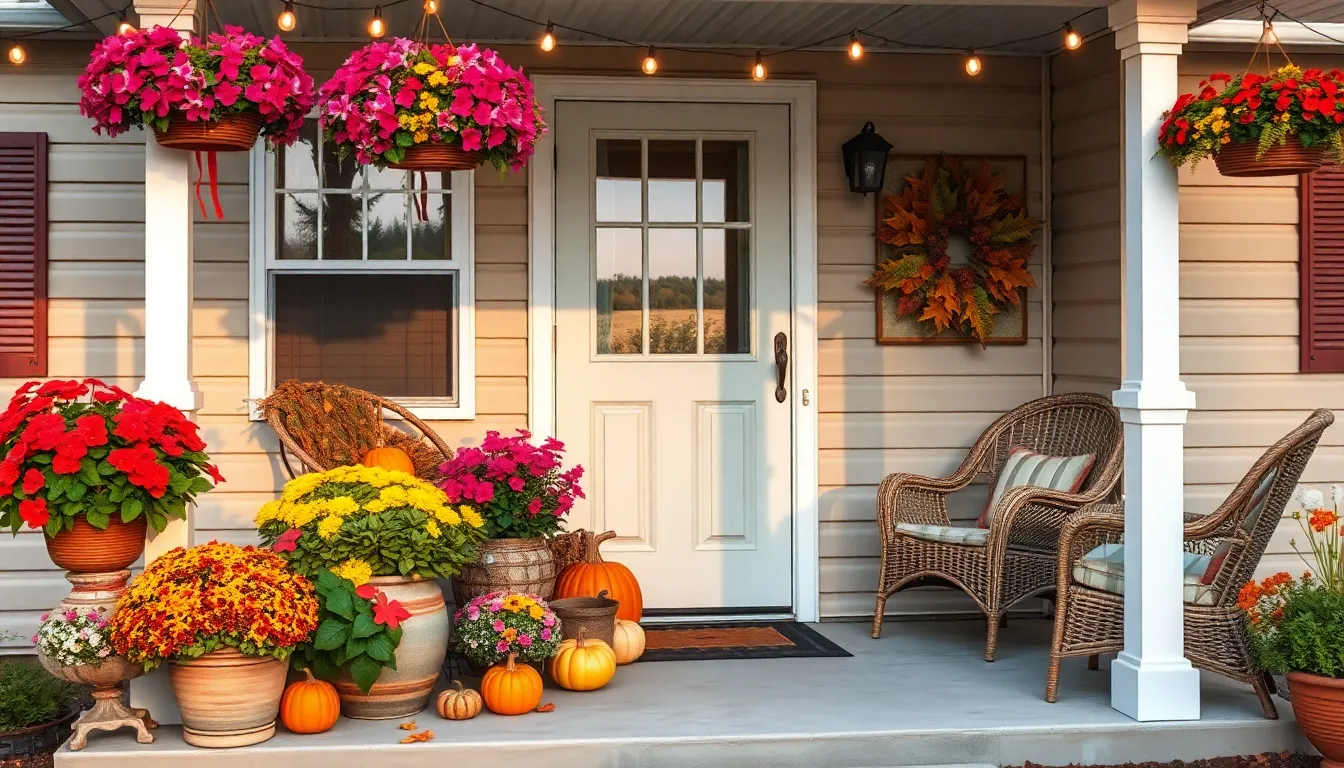
We can transform our mobile home front porch throughout the year with thoughtful seasonal decorating that enhances curb appeal and creates an inviting outdoor space. Seasonal themes allow us to refresh our porch’s appearance while celebrating each time of year with appropriate colors, textures, and decorative elements.
Spring and Summer Themes
Bright, fresh colors instantly evoke springtime cheer and create an uplifting atmosphere on our front porch. We should incorporate floral arrangements using seasonal blooms like daffodils, tulips, and petunias to add natural beauty and fragrance. Potted plants placed strategically around the porch perimeter provide flexibility for rearranging and seasonal changes.
Hanging baskets filled with trailing flowers like petunias or ivy create vertical interest and maximize our decorating space. Window boxes attached to porch railings offer additional planting opportunities while maintaining a neat, organized appearance. We can use these containers to showcase colorful annuals that bloom throughout the warmer months.
Lightweight furniture such as wicker chairs or classic rockers invites relaxation and enjoyment of pleasant weather. Outdoor rugs in cheerful patterns define seating areas while adding comfort underfoot and protecting porch surfaces. Cushions in vibrant colors or floral prints enhance seating comfort and can be easily swapped for different looks.
String lights create cozy evening ambiance as summer days extend into twilight hours. Lanterns placed on tables or hung from hooks provide warm lighting and add decorative appeal. We should choose weather-resistant lighting options that can withstand outdoor conditions while maintaining their attractive appearance.
Fall and Winter Adaptations
Warm hues like oranges, reds, and browns instantly transform our porch into a cozy autumn retreat. Pumpkins of various sizes create natural focal points and can be arranged in groups for maximum visual impact. Gourds, corn stalks, and colorful autumn leaves add texture and seasonal authenticity to our decorating scheme.
Layered outdoor blankets provide warmth during cooler evenings while adding visual interest through different textures and patterns. Textured pillows in fall colors enhance seating comfort and can be mixed and matched for a collected look. We should choose weather-resistant fabrics that can handle temperature changes and occasional moisture.
Natural elements such as pine cones, bare branches, and evergreen boughs bring the outdoors closer to our living space. These materials cost nothing to gather and provide authentic seasonal charm that complements our mobile home’s natural surroundings. We can arrange these elements in baskets or containers for organized displays.
Weatherproof lighting becomes essential as daylight hours decrease and temperatures drop. Battery-operated candles provide flickering ambiance without fire hazards or electrical complications. Solar lights charge during daylight hours and automatically illuminate our porch during evening hours.
Holiday wreaths and garlands transform our porch into a festive winter wonderland during the holiday season. We can attach these decorations to railings, posts, or doors for maximum visual impact. Weather-resistant materials ensure our decorations maintain their appearance throughout the winter months.
Holiday Decoration Tips
Halloween decorations should emphasize themed elements that create spooky atmosphere without overwhelming our porch’s architectural features. Carved pumpkins serve as traditional jack-o’-lanterns while providing natural seasonal charm. Spooky lights in orange or purple create dramatic evening effects, while cobweb accents add eerie touches to corners and railings.
Thanksgiving displays should emphasize harvest themes that celebrate autumn’s abundance and natural beauty. Cornucopias filled with seasonal produce create traditional focal points that embody the holiday’s spirit. Rustic signs with thankful messages or harvest greetings add personal touches and welcoming sentiments.
Christmas and winter holiday decorations require weather-resistant materials that maintain their beauty throughout the season. String lights in warm white or multicolored options create magical evening displays and highlight architectural features. Wreaths made from evergreen materials provide classic beauty and wonderful fragrance. Bows in traditional colors add festive touches to railings, posts, and doorways.
Personalized touches make our holiday decorations unique and reflect our family’s personality and style. Handmade signs with family names or holiday greetings create custom focal points that can’t be duplicated. Monogrammed pillows add sophisticated touches while maintaining comfort and functionality. Unique ornaments collected over time tell our family’s story and create conversation pieces.
Balanced decorations enhance rather than overwhelm our porch’s structure and existing architectural elements. We should avoid overcrowding spaces with too many decorative items that compete for attention. Instead, we can choose a few high-impact pieces that complement our porch’s scale and style while creating cohesive seasonal displays.
Porch Lighting and Electrical Features
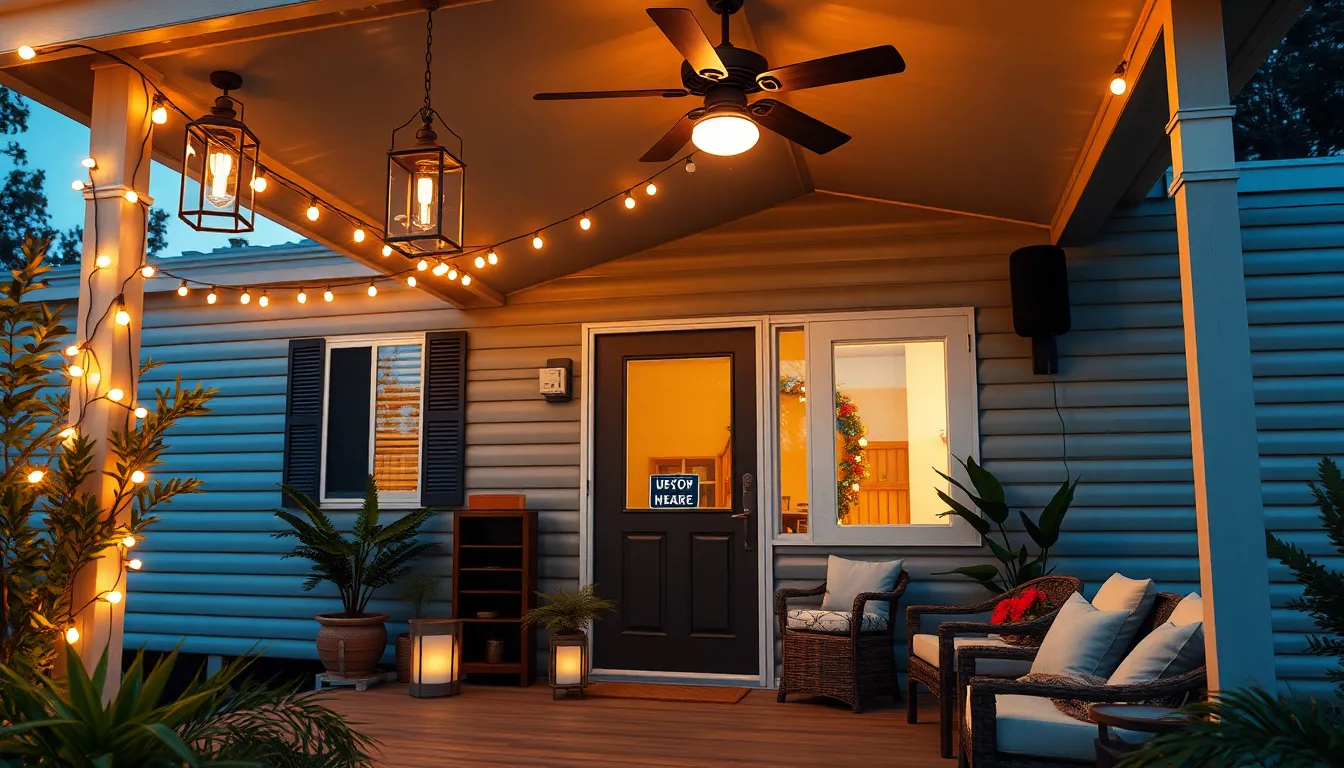
Creating the perfect atmosphere and functionality on your mobile home front porch requires thoughtful lighting and electrical planning. Strategic illumination transforms your outdoor space into a welcoming retreat that’s both beautiful and practical.
Ambient Lighting Options
String lights create magical warmth that instantly transforms any mobile home porch into an inviting gathering space. Solar-powered LED string lights offer the most popular energy-efficient choice, requiring no complex wiring while delivering beautiful ambient illumination perfect for evening relaxation and entertaining guests.
Lantern-style fixtures provide timeless charm that complements both traditional and rustic porch designs. We recommend choosing soft LED wall sconces that cast warm, indirect light to establish a cozy atmosphere without harsh shadows or glare.
Recessed lighting under porch roofs delivers subtle elegance while maintaining clean architectural lines. Installing these fixtures in the soffit creates a gentle glow that works beautifully with screened-in porches and modern minimalist designs.
Functional Electrical Additions
Electrical outlets on your porch unlock versatile functionality for powering fans, heaters, and essential tools during DIY projects. Adding weatherproof outlets ensures you can adapt your outdoor space for different activities and seasonal needs.
Porch ceiling fans with integrated lighting solve dual comfort challenges by improving air circulation during hot weather while providing overhead illumination. These fixtures work especially well in covered porches and wrap-around extensions where multiple zones need both cooling and light.
Motion sensor lights enhance security and convenience by automatically illuminating porch steps and entry areas when movement is detected. Installing these features creates safer navigation while deterring unwanted visitors without ongoing electricity costs.
Outdoor speakers and smart home devices extend your indoor comfort to the porch through electrical wiring that supports entertainment and automation systems. Connecting these features allows you to control lighting, music, and climate from your mobile device.
Solar-Powered Alternatives
Solar post cap lights eliminate wiring complexity while providing reliable illumination without ongoing electrical costs. These cost-effective installations work perfectly for highlighting porch railings and creating defined boundaries around your outdoor living space.
Solar spotlights and pathway lighting enhance landscaping around your mobile home porch using renewable energy sources. Positioning these fixtures strategically improves curb appeal while maintaining safe navigation paths during evening hours.
Portable solar lamps offer maximum flexibility for changing your porch layout or lighting mood without electrical work. We love how these renewable options let you experiment with different arrangements while maintaining environmental responsibility and reducing utility expenses.
Plant and Garden Integration
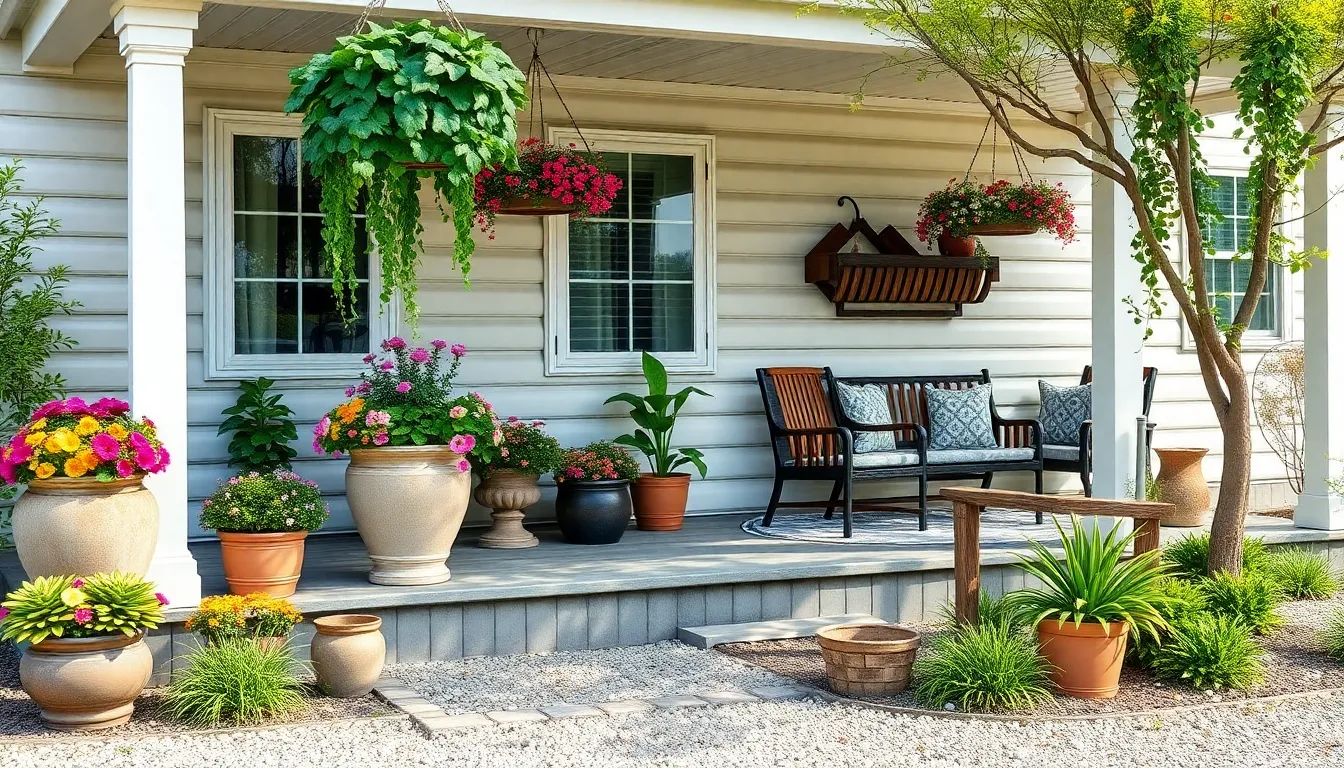
Adding plants and gardens to your mobile home porch creates a natural bridge between your outdoor and indoor living spaces. Strategic plant placement transforms a basic porch into a welcoming oasis that enhances curb appeal while providing year-round enjoyment.
Container Gardening Answers
Container gardening offers maximum flexibility for mobile home porches where ground space is limited. Large ceramic or wooden planters positioned at porch corners create natural focal points with ornamental grasses, seasonal flowers, or compact shrubs like boxwood or dwarf azaleas. We recommend choosing containers that complement your porch materials—galvanized metal planters work beautifully with modern designs, while rustic wooden barrels enhance country-style porches.
Mobility becomes a key advantage when you select containers with built-in wheels or drainage saucers. Seasonal plant swaps become effortless as you transition from spring tulips to summer petunias and fall mums. Strategic placement along porch railings with matching planters creates visual continuity while allowing easy access for maintenance and watering.
Hanging Plant Arrangements
Hanging baskets maximize vertical space without cluttering porch floors or walkways. Trailing plants like ivy, petunias, and spider plants create natural curtains that soften harsh architectural lines while adding privacy to seating areas. We’ve found that suspending planters from porch ceiling beams or mounting them on decorative brackets creates layered visual interest at different heights.
Chain or rope hanging systems offer flexibility for seasonal adjustments and plant rotation. Boston ferns and trailing geraniums thrive in partially shaded porch areas, while sun-loving nasturtiums and bacopa flourish in brighter exposures. Multiple hanging arrangements at varying heights create a lush canopy effect that transforms ordinary porches into garden retreats.
Low-Maintenance Landscaping
Native plants around your porch foundation require minimal watering and care while providing year-round structure. Drought-resistant shrubs like lavender, rosemary, and ornamental grasses establish themselves quickly and maintain their appearance with minimal intervention. Mulched beds retain soil moisture while suppressing weeds, reducing maintenance time and creating neat, finished edges.
Gravel pathways paired with hardy ground covers like creeping thyme or sedum offer attractive alternatives to traditional lawn maintenance. Stone or brick edging defines planting areas while preventing mulch migration and grass encroachment. We recommend selecting plants that naturally complement your climate zone, ensuring thriving growth without constant attention or expensive soil amendments.
Conclusion
Your mobile home’s front porch holds incredible potential to become the welcoming centerpiece your home deserves. We’ve explored everything from classic covered designs to modern minimalist approaches and budget-friendly DIY answers that can transform your entrance without very costly.
Whether you’re drawn to screened-in additions for year-round comfort or wrap-around extensions for maximum impact these ideas prove that mobile home porches can be just as stunning and functional as any traditional home. The key lies in choosing elements that reflect your personal style while maximizing your available space.
From strategic lighting and plant integration to seasonal decorating and smart storage answers we’ve shown you how small changes can create big results. Your front porch is more than just an entrance—it’s your home’s first impression and your personal outdoor retreat waiting to be discovered.
Frequently Asked Questions
What are some budget-friendly ways to improve a mobile home porch?
You can transform your mobile home porch affordably using faux rock panels for columns, composite decking materials, and reclaimed wood. Simple DIY projects like basic front steps, screened panel installations, and repurposed decorations such as pallet swings and mason jar lighting can enhance your porch’s appeal without breaking the bank.
Do I need construction experience to renovate my mobile home porch?
No, many mobile home porch improvements don’t require extensive construction skills. Simple projects like adding decorative railings, installing lighting, basic landscaping, and seasonal decorating can be completed by beginners. However, major structural changes like wrap-around extensions may require professional consultation and permits.
What’s the difference between classic and modern minimalist porch designs?
Classic porch designs feature traditional elements like steep gable roofs, wooden posts, spindle railings, and farmhouse charm. Modern minimalist designs emphasize clean lines, simple materials like metal railings and concrete steps, neutral color palettes, and streamlined furniture that prioritizes functionality over ornamentation.
How can I maximize space on a small mobile home porch?
Use compact, multi-functional furniture like foldable tables, bench seating with storage, and ottomans. Implement vertical decoration strategies with hanging planters and wall-mounted shelves. Consider built-in features like railing planters and overhead coverings to maximize both functionality and aesthetic appeal without crowding the space.
What are the benefits of adding a screened-in porch to my mobile home?
Screened porches extend your outdoor living space while protecting against insects and debris. They offer weather protection with options like roll-down vinyl screens and storm panels. Features like UV-blocking materials, ceiling fans, and insulated windows can make the space usable year-round in various climates.
How do I choose the right plants for my mobile home porch?
Consider container gardening for flexibility, using various planter styles that complement your porch design. Opt for low-maintenance, native plants that suit your climate. Hanging arrangements maximize vertical space and add privacy, while selecting plants based on sunlight exposure and watering requirements ensures long-term success.
What lighting options work best for mobile home porches?
Ambient lighting options include solar-powered LED string lights and lantern-style fixtures for atmosphere. Functional additions like weatherproof outlets and ceiling fans with integrated lighting enhance usability. Solar alternatives such as post cap lights and portable solar lamps provide flexibility while reducing utility costs.
Do I need permits for mobile home porch modifications?
Permit requirements vary by location and project scope. Minor improvements like decorating, lighting, and furniture typically don’t require permits. However, structural changes, wrap-around extensions, electrical work, and screened additions often need permits and should comply with local building codes. Always check with local authorities first.

